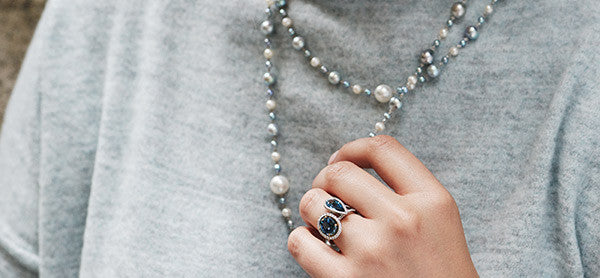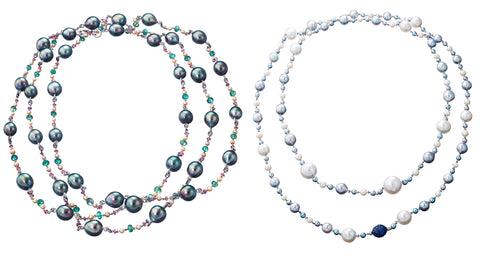
Pearls of wisdom:
Top 10 facts everyone should know
Layer your pearls with a grey T-shirt for an effortless, contemporary look. STELLA - Grey and blue pearl necklace, € 17.500.
Pearls of wisdom: top 10 facts everyone should know
Forget the prim and proper neatness of a single string of pearls - these shimmering, lustrous gems are becoming ever-more chameleonic and versatile - alluring with a little black dress yet cool and offbeat with jeans and a grey T-shirt.
Here at Aenea we love the myriad colours, shapes and sizes of pearls - from deep, peacock hues to sky blues and peachy pinks. As we celebrate the launch of our new pearl collection, STELLA, we’ve discovered some fabulous facts about pearls, a versatile and vibrant gemstone that’s setting a new agenda in fashion and jewellery.
-
Pearls are the only gemstones derived from living creatures
And one oyster can produce several pearls in its lifetime. Traditionally, a pearl is grown through ‘periculture’ where an oyster or mussel is fed a tiny bead, which a lustrous pearl is formed around. Pearls are cultured in both freshwater and salt water, with different shapes and size of mollusc producing the many different types and colours of pearl.
-
Use your teeth to check if they’re real
No, seriously! Here is one to try at home - test to see if your pearls are real or faux by running your teeth gently over the surface of a pearl. If it feels a little bit gritty or grainy, then you have real pearls.
Chameleonic in its colours, Aenea’s pearl jewellery is the finishing touch to your effortless weekend outfit. STELLA Earrings Grey Tahiti € 3.400, STELLA Necklace Grey Tahiti Pearls Fancy stones € 24.000.
- Pearls have been highly regarded through history
These beautiful, shimmering gems have long been a symbol of status and wealth, with pearl-set adornments dating back as early as 2,300 BC, and even found in Egyptian tombs. During the Renaissance, some European countries even passed laws stating that only nobility could wear them. Luckily Aenea pearls are for everyone - especially those with good taste!
-
A truly natural pearl can cost millions
Today, most pearls are cultured, but truly natural, good-quality pearls are very rare - found in about one in every 10,000 oysters. Therefore, natural pearls command very high prices. In 2015, a four-strand natural pearl necklace sold at auction at Christie’s New York for a dazzling $5.1 million (EUR 4.5m).
-
The Emirates once supplied 70% of pearls to market
The Middle East was the world’s foremost supplier of natural pearls to the jewellery trade until the 1950s, when the boom in cultured pearls - developed in Japan - swamped the market, and the Middle East’s famous oil trade eclipsed its pearl production.

The beautiful rainbow iridescence of Tahitian pearls is complemented by Aenea’s STELLA Necklace Grey Tahiti Pearls Fancy stones (left) € 24.000., while cool white and grey pearls are complemented by deep, ink-blue sapphires (right) STELLA Necklace Blue Pearls with Sapphires €12.500.
-
Pearl jewellery has its own vocabulary
Did you know there are special terms to describe the length of pearl necklaces? Classic strings of pearls can be called Collar (12”), Princess (18”) or Matinee (24”), with Opera (36”) and Rope (45”+) determining the most daring styles, often wrapped several times around the neck to cascade down the body.
-
South Sea pearls are very rare
Occurring only in the waters around South East Asia and Australia, these white and golden yellow-hued pearls are also some of the largest in size, growing up to 15mm. They’re so rare that to compare by weight, annual diamond mining production is about 10 times greater than the weight of the yearly Australian South Sea pearl harvest.
Aenea’s STELLA Akoia Keshi Pearls Keji pearl necklace features subtle green and grey pearls surrounded by roundels of diamonds € 35.000.
-
Tahitian pearls can shimmer with rainbows
While typically called ‘black pearls’ for their darker body colour, Tahitian pearls - like the beautiful ones used by Aenea - can shine with a spectrum of iridescent hues, making them perfect for teaming with coloured gemstones. Grown inside black-lip pearl oysters, which have a rainbow-like interior known as mother of pearl, Tahitian pearls are imbued with this rainbow lustre, while themselves occurring in dove grey and peacock greens through to deep metallic blacks.
-
Pearls should be your finishing touch
Pearls are a porous gemstone. They can soak up perfumes or moisturisers on the skin, which can in turn affect their lustre. So, wait until your perfume is dry and put on your pearls as a ‘finishing touch’. And to clean your pearls? After each wear, delicately polish them with a lint-free cloth.
-
Pearls are like fingerprints
Each one is truly unique, and matching pearls by colour and size - especially larger Tahitian pearls - can take many years for a jewellery company. One of the largest and most famous pearls in recent history is La Peregrina (‘The Incomparable’). This striking pear-shaped pearl is about 500 years old and has been owned by Napoleon Bonaparte, the King of Spain and even Elizabeth Taylor, who wore it on a pearl and ruby necklace.
Pearls are beautifully playful, whether worn as a layered necklace or wrapped elegantly around the wrist, STELLA - Necklace Grey and blue pearls € 17.500.
Want to know more about pearls?
Join us at our AENEA Atelier in Salzburg or contact us for more information about these beautiful gemstones and our bespoke pearl designs email: atelier@aenea.com





